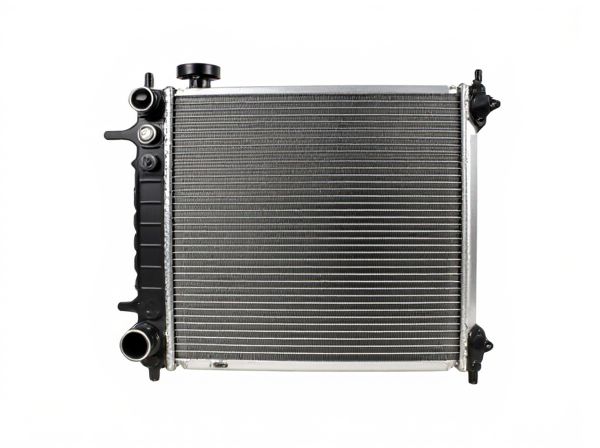
Photo illustration: Double Core Radiator vs Triple Core Radiator
A triple core radiator offers enhanced cooling efficiency compared to a double core radiator due to its increased surface area, making it ideal for high-performance or heavy-duty vehicles. Your choice depends on your vehicle's cooling requirements and the engine's heat output, with triple core radiators providing better heat dissipation but potentially higher costs and weight. For everyday driving, a double core radiator often provides adequate cooling while maintaining lighter weight and cost-effectiveness.
Table of Comparison
| Feature | Double Core Radiator | Triple Core Radiator |
|---|---|---|
| Cooling Efficiency | Moderate cooling capacity, suitable for standard engines | High cooling capacity, ideal for high-performance engines |
| Core Thickness | Typically 25-30mm | Typically 40-45mm |
| Weight | Lighter due to fewer cores | Heavier because of added core layer |
| Price | More affordable | Higher cost due to enhanced design |
| Durability | Standard durability | Better durability with improved heat dissipation |
| Ideal Use | Daily driving and light load vehicles | Performance and heavy-duty vehicles |
Introduction to Double and Triple Core Radiators
Double core radiators feature two layers of cooling fins and tubes, offering balanced heat dissipation ideal for standard vehicle cooling requirements. Triple core radiators contain three layers of cores, significantly increasing surface area for superior heat transfer and enhanced cooling efficiency, suitable for high-performance or heavy-duty applications. Selecting between double and triple core radiators depends on the engine cooling demand, space availability, and vehicle performance needs.
How Radiator Core Count Affects Performance
Radiator core count directly influences cooling efficiency by increasing surface area for heat dissipation; double-core radiators offer balanced cooling suitable for moderate engine heat output, while triple-core radiators provide enhanced thermal management by accommodating higher heat loads from performance or heavy-duty engines. The increased core count results in better coolant flow and air exchange, reducing engine temperatures more effectively during high-stress conditions. However, triple-core radiators may cause higher weight and airflow resistance, potentially impacting overall vehicle performance if not properly matched to the engine's cooling requirements.
Cooling Efficiency: Double vs Triple Core Radiators
Triple core radiators offer superior cooling efficiency compared to double core radiators due to their increased surface area and additional coolant channels, allowing for better heat dissipation. Double core radiators provide adequate cooling for moderate engine outputs but may struggle under high-performance or heavy-duty conditions where thermal management is critical. Choosing a triple core radiator enhances thermal regulation in demanding environments, reducing the risk of engine overheating and improving overall vehicle performance.
Space and Fitment Considerations
Double core radiators offer a more compact size, making them ideal for vehicles with limited engine bay space where fitting a larger radiator is challenging. Triple core radiators provide increased cooling capacity but require additional clearance and mounting modifications due to their thicker design. Choosing between them depends on available space, cooling demands, and compatibility with existing vehicle components.
Impact on Engine Temperatures
Double core radiators provide efficient heat dissipation suitable for standard engine cooling needs, maintaining optimal engine temperatures under normal driving conditions. Triple core radiators increase cooling capacity by having a thicker core and more cooling tubes, significantly reducing engine temperatures during high-performance or heavy-duty applications. This enhanced heat exchange prevents overheating, prolongs engine life, and boosts overall vehicle performance in demanding environments.
Durability and Build Quality Comparison
Double core radiators typically feature thicker aluminum or copper fins and reinforced tanks, providing solid durability for standard cooling demands, while triple core radiators incorporate more cooling layers that enhance heat dissipation but may introduce complexity in construction. Triple core radiators often use higher-grade materials and improved welding techniques, resulting in superior build quality and resistance to corrosion under heavy-duty or high-performance conditions. Both types benefit from specialized coatings and pressure-tested designs, but triple core radiators generally deliver enhanced longevity and structural integrity in demanding automotive or industrial applications.
Cost Differences: Double vs Triple Core
Double core radiators generally cost less than triple core radiators due to simpler manufacturing processes and lower material usage. Triple core radiators offer enhanced cooling performance but come at a higher price point, reflecting their increased size and complexity. When choosing between double and triple core radiators, budget constraints often dictate opting for the more affordable double core option unless superior cooling efficiency is essential.
Installation Complexity and Requirements
Double core radiators typically offer simpler installation processes due to fewer coolant channels and lighter weight, making them suitable for standard vehicle cooling systems with limited space. Triple core radiators require more precise fitting and may necessitate modifications to the radiator support or adjacent components because of their increased thickness and added cooling layers. Proper installation of triple core radiators often demands enhanced tools and experience to ensure correct radiator hose alignment and avoid potential airflow restrictions.
Which Radiator is Best for Your Vehicle?
Choosing between a double core radiator and a triple core radiator depends on your vehicle's cooling needs and engine performance. Triple core radiators offer enhanced heat dissipation and are ideal for high-performance or heavy-duty vehicles that generate more heat, while double core radiators provide sufficient cooling for standard or everyday driving conditions. Factors such as engine size, driving environment, and vehicle load help determine the best radiator type to maintain optimal engine temperature and prevent overheating.
Conclusion: Making the Right Choice
Choosing between a Double Core Radiator and a Triple Core Radiator hinges on your vehicle's cooling needs, with the Triple Core Radiator offering superior heat dissipation for high-performance or heavy-duty applications. Double Core Radiators are suitable for everyday driving, providing reliable cooling with less weight and complexity. Opt for a radiator that matches your engine's thermal output and your driving conditions to achieve optimal performance and longevity.
 caratoz.com
caratoz.com